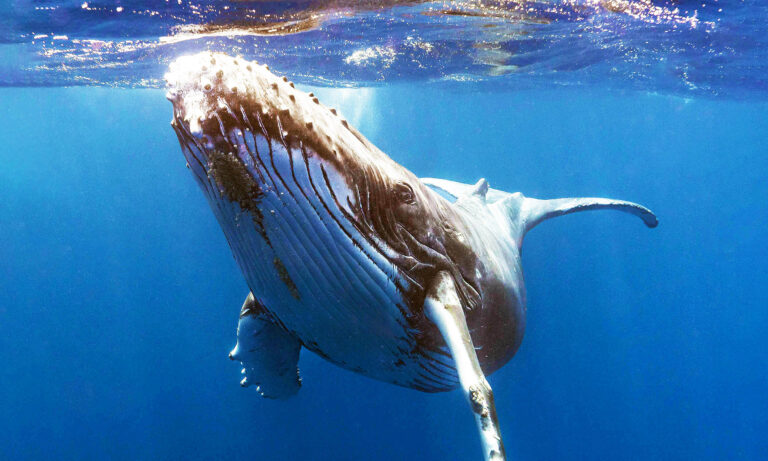In a surprising encounter off the coast of Alaska, human scientists had what they called a “conversation” with a humpback whale named Twain. Dr. Brenda McCowan of the University of California, Davis, was the central figure in this unexpected interaction.
Dr McCowan and his team, known as ‘Whale-SETI’, have been studying how humpback whales communicate. They aim to understand whale communication systems that will help in the search for extraterrestrial life.
Whales responding to human greetings
The researchers used underwater speakers to broadcast recorded humpback whale “contact” calls out into the ocean. To their surprise, Twain approached their boat and began responding.
For about 20 minutes, the whales circled around the whale, matching the intervals between its calls.
“We believe this is the first communication between humans and humpback whales using humpback whale ‘language,'” Dr McCowan said.
Researchers were excited to see such a direct interaction using the whale’s own signals.
The science behind encounters
The Whale-SETI team is working to develop filters to detect intelligent signals that can be used in the search for extraterrestrial intelligence.
By studying how whales communicate, they hope to find patterns that can be applied to signals from space.
Dr. Fred Sharp of the Alaska Whale Foundation emphasized how intelligent humpback whales are. He pointed out their complex social system and unique behavior.
“They make tools such as foam nets to catch fish, and they communicate extensively through songs and social calls,” Dr Sharp explained.
humans, whales, extraterrestrials
The behavior they observed in Twain supports an important idea in the search for life beyond Earth.
“Due to the limitations of current technology, a key assumption in the search for extraterrestrial intelligence is that extraterrestrials are interested in contact and will target human receivers,” SETI Institute Dr. Laurence Doyle points out.
“This important hypothesis is certainly supported by the behavior of humpback whales.”
The researchers believe that by interacting with whales, they can learn how to detect and understand intelligent signals, whether they come from the deep ocean or beyond space.
This amazing encounter is detailed in an article titled “Interactive bioacoustic playback as a tool for the detection and exploration of non-human intelligence: ‘Conversations’ with Alaska’s humpback whales” in the journal Peer J. Published.
The researchers plan to use mathematics and various forms of artificial intelligence (AI), particularly information theory and machine learning, to measure how complex whale communication is. They want to understand the rules and structure of the messages they receive.
Human-whale conversation — what happens next?
The Whale-SETI team doesn’t stop there. They are preparing another paper that will focus on non-vocal ways humpback whales may communicate, such as the bubble rings they create around humans.
Co-authors Dr. Josie Hubbard, Lisa Walker, and Jodi Frediani bring expertise in animal intelligence, whale song analysis, and whale behavior to this project.
The research team is grateful for funding from the Templeton Foundation Diversity and Intelligence Program, which helped make the study possible.
What is Whale-SETI?
Whale-SETI, short for Whale Search for Extraterrestrial Intelligence, is a unique project that combines marine biology with the search for extraterrestrial life.
Researchers are trying to decipher whale communication, and the idea is that these sounds may contain complex messages similar to human or even extraterrestrial languages. We are conducting research based on this.
We use advanced technology, including advanced underwater microphones and artificial intelligence, to record and analyze whale sounds.
The AI looks for patterns that may indicate language-like structure. Not only will this help us better understand whales, but it could also improve how we search for intelligent life elsewhere.
Why humans should care about humpback whales
Humpback whales are fascinating creatures. They can grow up to 60 feet long and weigh up to 40 tons.
Scientifically known as Megaptera novaeangliae, these whales are easily identified by their long pectoral fins and knobby heads.
They travel long distances, traveling up to 5,000 miles between feeding and breeding grounds.
Their songs are complex and melodious and play an important role in their social interactions, especially during the breeding season.
Humpback whale populations, once hunted to the brink of extinction, are recovering thanks to international conservation efforts.
However, they still face threats such as entanglement in fishing gear, collisions with ships, and environmental changes caused by climate change.
Understanding their communication and social structure will inform conservation efforts that ensure these majestic creatures continue to thrive in our oceans.
Role of SETI Institute
Founded in 1984, the SETI Institute is dedicated to the search for life beyond Earth.
By studying signals from space and understanding how life arises elsewhere, they aim to answer the deep question: “Are we alone in the universe?” .
Their work with Whale-SETI is an exciting intersection of this pursuit and the study of intelligent life on our planet.
What does that mean?
In summary, this encounter with Twain is more than just a fascinating story about man and whale. This is a step toward understanding intelligence in all its forms.
By learning how to communicate with humpback whales, scientists hope to one day develop tools to help recognize and understand messages from extraterrestrial life.
What does this mean for us? It emphasizes the importance of keeping a close eye on the intelligent life forms with which we share our planet. Perhaps by understanding the minds of whales, we can better prepare for encounters with extraterrestrial life.
—–
The group supporting this research includes scientists from the SETI Institute, the University of California, Davis, and the Alaska Whale Foundation.
The entire study was published in the journal PeerJ.
—–
Like what you read? Subscribe to our newsletter for fascinating articles, exclusive content and the latest updates.
Check us out on EarthSnap, the free app from Eric Ralls and Earth.com.
—–


